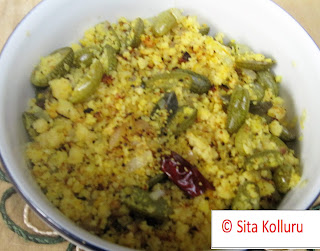Idli is an age old breakfast dish in South India. Now, it gained popularity, not only all over india, but in many other countries also. Idlis are steam cooked, fat free and make a delicious breakfast dish or snack!
Main ingredients for regular idli are urad dal and rice. But the preparation takes a long time as the dal has to be soaked, ground and fermented. During winter season, it is difficult to ferment the batter.
There are variations of regular idli where the fermentation is not needed and you can have instant idlis! One of such variations is ravva/ semolina/cream of wheat idlis.
Idlis are steam cooked in a special container available in many Indian stores in USA. Even if you do not have the container, you can use the "idli stand", a set of plates you can place in a pressure cooker or instant pot.
Ravva idli mix is commercially available and is available in many Indian stores in USA. But, it is easy to make your own batter and not too time consuming. So, even if you do not have an Indian store in your vicinity, ravva idlis can be made at home!
Ingredients:
Directions:
Main ingredients for regular idli are urad dal and rice. But the preparation takes a long time as the dal has to be soaked, ground and fermented. During winter season, it is difficult to ferment the batter.
There are variations of regular idli where the fermentation is not needed and you can have instant idlis! One of such variations is ravva/ semolina/cream of wheat idlis.
Idlis are steam cooked in a special container available in many Indian stores in USA. Even if you do not have the container, you can use the "idli stand", a set of plates you can place in a pressure cooker or instant pot.
Ravva idli mix is commercially available and is available in many Indian stores in USA. But, it is easy to make your own batter and not too time consuming. So, even if you do not have an Indian store in your vicinity, ravva idlis can be made at home!
- 1 cup sooji/ Bombay ravva or Cream of wheat
- 1/2 to 3/4 cup curd (yogurt)
- 2 Tbsp. oil
- 1 Tsp. chana dal
- 1 Tsp. urad dal
- 1/2 Tsp. mustard seeds
- Pinch of hing (asafetida)
- 1 green chile chopped
- 1/2 inch ginger chopped
- 1 medium size carrot grated
- 2 or 3 beans chopped fine
- 2 Tbsp. red bell pepper or red sweet chile chopped
- A few curry leaves
- 1/2 Tsp. baking soda
- Salt to taste
Directions:
- Heat oil in a thick wide pan.
- Add chana dal, urad dal and mustard seeds.
- Keep stirring.
- Add asafetida.
- When the dal is getting brown in color, add chile and ginger pieces.
- Saute for a minute and add carrot, beans and red pepper pieces.
- Keep stirring.
- When the vegetables are getting soft, add the ravva (cream of wheat).
- Add salt.
- Mix well and let it roast for about 5 minutes.
- When the ravva is turning brown and has a nice aroma, turn off the heat.
- Let it cool for some time.
- When the mixture is at room temperature, take curd/yogurt in a vessel and add about 1/2 cup of water.
- Whisk it well so that thick buttermilk is formed.
- Add the roasted ravva mixture and mix well.
- Let it stay for ten minutes.
- If the mixture is too thick, add some more water so that the batter has idli batter consistency.
- The batter should fall down easily from the spoon as you mix it,
- Add the baking soda and mix well till the batter turns frothy.
- Grease the idli plates and pour 2 or 3 table spoons of batter in each mold.
- Steam the idlis for about 10 minutes and turn the heat off.
- Let the idlis cool for a few minutes and remove from the plates.
- Serve with sambar and chutney.


















































